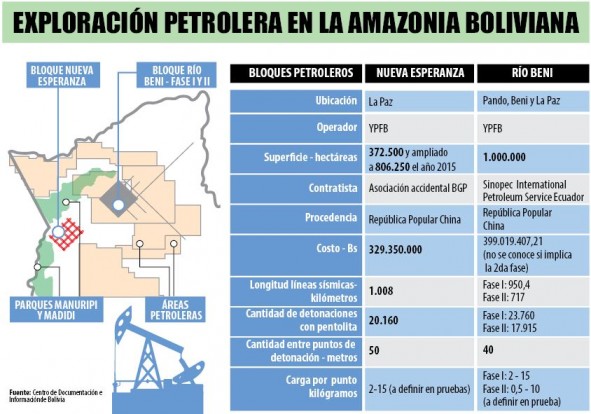- The government argues that oil exploration activity will help to “reduce extreme poverty in the communities living in protected areas.”
- The majority of national parks already witness oil exploration activity. Some, like Iñao, Aguaragüe, Pilón Lajas and Madidi parks have had between 75% and 90% of their territories committed under oil exploration contracts.
- These exploration projects have been authorized under Bolivian law, the Decreto Supremo (DS) 2366, which was approved in May of 2015.

On January 30, 2015, Bolivian president Evo Morales gave the green light to oil exploration in Lliquimuni, north of the capital, La Paz. The Lliquimuni Block is located on a mountain range thick with vegetation, on the edge of the country’s Amazon region.
“The drill is already installed,” said president Morales during a press conference held in Lliquimuni. “We have good leads to believe there is oil there.”
According to the state oil company, Yacimientos Petrolíferos Fiscales Bolivianos (YPFB), they will know by the end of this year whether there is oil or gas or nothing at all underneath the Lliquimuni Block, one of the many new areas of gas and oil exploration located in Bolivia’s Amazon –or near it.
In recent years, oil companies such as Andina, Total, Chaco, Repsol, Maxus, Petrobras and Don Wong, among others, have obtained more than 25 concessions to explore and exploit hydrocarbons in protected areas throughout Bolivia, according to data from the National Service of Protected Areas (Servicio Nacional de Áreas Protegidas or SERNAP).
The government argues that the oil activity will serve to “reduce extreme violence among the communities that live in the protected areas.” However, SERNAP fears that the extractive industries, along with the expansion of the agricultural frontier and of human settlement areas, are already generating a lot of serious social and environmental problems, such as the construction of roads, mining activities, and the contamination of waterways.
Protected areas such as Madidi, Amboró, Isiboro-Sécure and Aguaragüe are among those most at risk. Within them, the most sensitive are the parks’ primary forests, indigenous territories, and breeding sites for endemic flora and fauna.
According to last year’s report from the Center for Documentation and Information Bolivia (Centro de Documentación e Información Bolivia or CEDIB), currently the surface of protected areas in the country is approximately 18,271,699 hectares. About 17% is threatened by oil activity, and the organization expects more of it will be in the near future.
“YFPB recognizes that [they are working] in eight important parks; in Amboró, TIPNIS, and Madidi, which make up the Vilcabamba – Amboró corridor. This is one of the most biodiverse regions in the world, and so this is problematic”, said CEDIB researcher Jorge Campanini to the Página Siete news site.
For Campanini, the data shows some alarming trends: the majority of Bolivia’s protected parks already witness oil exploration. Some, like Iñao, Aguaragüe, Pilón Lajas and Madidi parks have had between 75% and 90% of their territories committed under oil exploration contracts.
The great push towards oil and gas exploration in Bolivia started in early 2013. During the Third International Gas & Oil Congress, vice president Álvaro García Linera announced that YPFB would start working in national parks since these were “areas with large amounts of oil and gas.” At that time, García Linera assured the public that the work of the oil companies would go hand in hand with environmental mitigation policies.
The authorization for these projects was cemented in Supreme Decree (DS) 2366, approved in May 2015. “It allows the development of hydrocarbon exploration in different parts and categories of protected areas,” stated the norm.
Since then, other Supreme Decrees have extended exploration areas within Bolivia’s Amazon region. According to Campanini, in 2012 the country’s oil frontier occupied close to 24 million hectares; currently, it has grown to more than 31 million hectares.
“Something that causes a lot of concern is the fact that the decrees have created new areas extending towards [the states of] Beni and north of Pando,” explained Campanini in an interview with the Los Tiempos newspaper. “This radically increases the oil frontier.”

